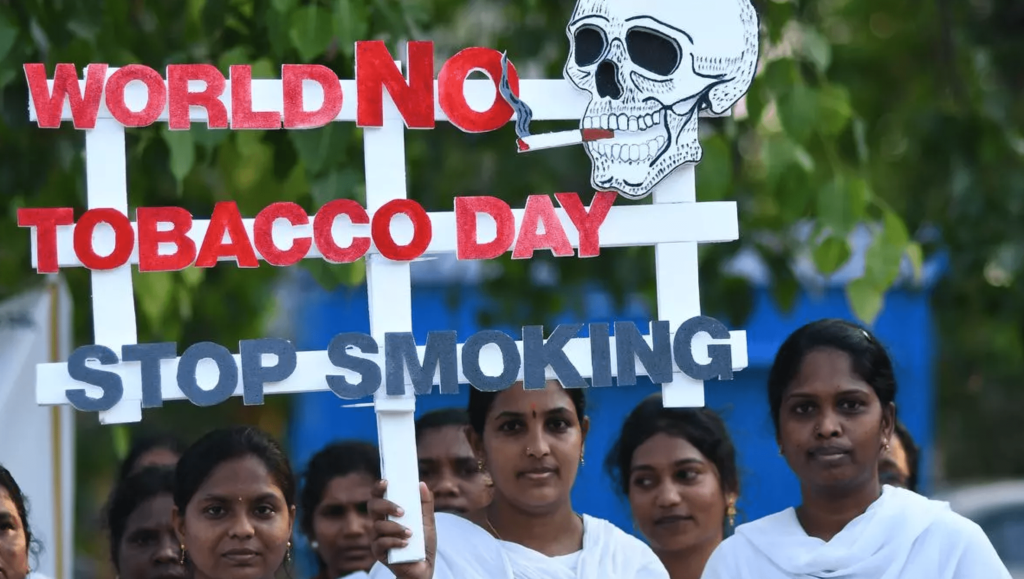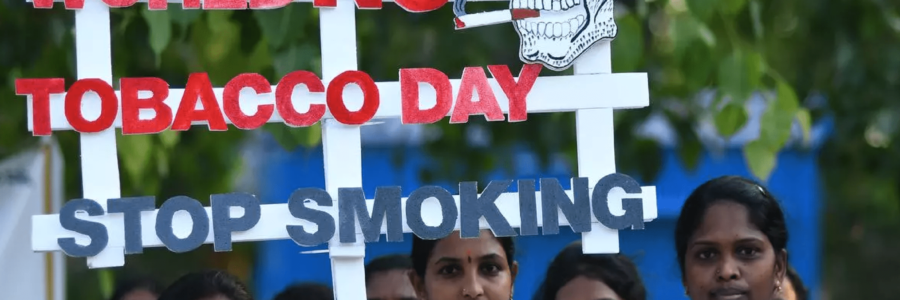Apart from campaigns to curb consumption, tobacco farmers must be provided with alternative livelihoods.
Authors: Mayank Mishra and Swathi Rao
This is an unabridged version of the article published in the Hindu Business Line on May 31, 2023.
India, a country recognized globally as a “best practices” country in tobacco control according to the framework implemented by the World Health Organization (WHO), faces significant challenges in curbing tobacco consumption. Following the observance of World Tobacco Day, , it is crucial to emphasise the importance of monitoring and evaluation of anti-tobacco programs and why this is relevant for India and the global community.

Tobacco is a well-known health hazard, causing 8 million deaths globally each year. Over 80% of the world’s tobacco users live in low- and middle-income countries. Tobacco consumption is undoubtedly one of the most pressing public health challenges of our time. Beyond the immediate health risks, tobacco also pollutes the air, exposes non-smokers to second-hand and third-hand smoke, contaminates water sources, and harms marine life. Even electronic smoking devices contribute to environmental damage due to toxic materials.
Recognising tobacco’s severe impact on public health and the environment, nations worldwide have committed to The United Nations Sustainable Development Goals (SDGs); to strengthen the implementation of the WHO Framework Convention on Tobacco Control (WHO FCTC). The FCTC aims to reduce tobacco consumption, protect non-smokers, and mitigate environmental damage. Controlling tobacco consumption is crucial not only as an SDG target but also for achieving other SDG targets linked to health, poverty, food security, education, among others.
The latest data from the National Family Health Survey-5 (NFHS-5) suggests that tobacco usage remains a significant public health concern, with 7% of all deaths in people aged 30 and over attributed to tobacco consumption. Tobacco use is also a major risk factor for non-communicable diseases like cardiovascular disease, cancer, chronic lung disease, and diabetes, which are responsible for 63% of all deaths in India. According to the Policy Tracker for Districts developed by The India Policy Insights initiative (IPI), at Harvard University, tobacco consumption rates vary greatly across districts, with prevalence ranging from 6.8% to 80.6% among men and 0.1% to 70.6% among women. The prevalence of tobacco use differs throughout the nation, with the eastern and northeastern regions displaying the highest rates of consumption.
Prevailing sociocultural norms also gender the consumption patterns in India. On average in the country, nearly 9% women and 38% men aged 15 and above consumed tobacco. The neighbouring districts of Kolasib and Mamit in Mizoram had the highest tobacco consumption rates for women (70.6%) and men (80.6%), respectively. It is worth noting that smokeless tobacco products, linked to various health issues, including several types of cancers, higher risks of premature delivery and stillbirth during pregnancy, nicotine poisoning in children, and an increased risk of death from heart disease and stroke, are deemed more acceptable for women’s consumption. According to WHO’s Global Adult Tobacco Survey (GATS, 2016-17), consumption of smokeless tobacco was the highest in Tripura.
More recently, a study of India’s progress on SDGs and subsequent SDG tracker published by IPI, showing 2021 performance data for all Indian districts, raised serious concerns regarding the consumption of tobacco among men. Approximately 83% of all districts in India are not on track to reduce the prevalence of tobacco use among men aged 15 years and older to 5% by 2030. For women, however, the data is more reassuring, as a majority (69%) of districts have either already achieved or are on track (17.4%) to achieving the SDG target. This disparity underscores the importance of closely monitoring the progress of anti-tobacco initiatives and tailoring interventions to address the specific needs and challenges faced by different population groups.
Tobacco use increases the risk of developing non-communicable diseases like chronic respiratory diseases, cancer, and diabetes. It is alarming that the prevalence of moderate to high blood pressure and diabetes, among men and women, has risen in most districts across the country. Controlling tobacco consumption becomes even more crucial in this backdrop, given its significant role in reducing the risk and burden of non-communicable diseases.
To strengthen anti-tobacco efforts, the Government of India launched the National Tobacco Control Programme (NTCP) in 2007-08, focusing on training, information campaigns, school programs, monitoring laws, and setting up cessation facilities. However, according to reports from WHO , there is a concerning decline in India’s score on monitoring performance data. Therefore, prioritising regular evaluation of policies is crucial to ensure effective monitoring and improve data collection on tobacco consumption. Robust monitoring mechanisms, such as leveraging tools like the IPI’s District and SDG Trackers, can enhance the government’s data monitoring capacity and provide valuable insights for informed decision-making.
On World Tobacco Day, the significance of monitoring and evaluation in anti-tobacco programs cannot be overstated. Equally important is the consideration of tobacco farmers and their communities during the shift away from tobacco cultivation. The implementation of “just transition” strategies, prioritising the well-being and economic stability of tobacco farmers, plays a pivotal role. This can encompass providing financial support, organising skill development programs, and ensuring access to resources for transitioning to alternative crops or industries.
Swathi Rao and Mayank Mishra are, respectively, Analyst and Manager at The Quantum Hub
The IPI Policy Tracker for Districts can be accessed here
The IPI SDG Tracker can be accessed here
